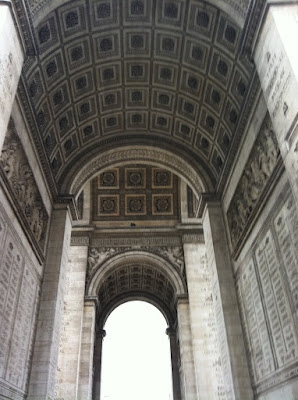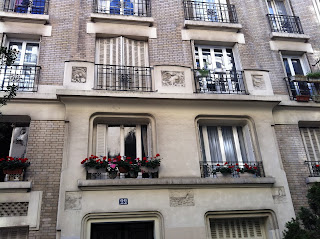Last evening Francois and I attended a reception hosted by Lieutenant-Commander André Gervais, Commanding Officer, HMCS RADISSON, Navel Reserve Division (http://www.navy.forces.gc.ca/navres/1/1-n_eng.asp?category=93) on board the HMCS Shawinigan in Trois-Rivières. The Shawinigan and two other maritime vessels are on Great Lakes deployment to selected ports along the St. Lawrence Seaway.
A bit of background on the Shawinigan:
HMCS Shawinigan(http://www.navy.forces.gc.ca/shawinigan/0/0-s_eng.asp) is a Kingston-class coastal defence vessel that has served in the Canadian Forces since 1997.
Shawinigan is the fifth ship of her class which is the name for the Maritime Coastal Defence Vessel Project. She is the second vessel to use the designation HMCS Shawinigan.
Shawinigan was laid down on 26 April 1996 at Halifax Shipyards Ltd., Halifax and was launched on 15 November 1996. She was officially commissioned into the CF on 14 June 1997 and carries the pennant number 704. She is assigned to Maritime Forces Atlantic (MARLANT) and is homeported at CFB Halifax.
In 1997 the Shawinigan was christened by Aline Chrétien (wife of Canada’s 20th Prime Minister, Jean Chrétien) and this evening she was honoured with a photo of the original launch. During the presentation it was explained that she made 25 attempts to break the bottle of Champaign on the hull of the ship, finally with success, an event that was well documented on This Hour Has 22 Minutes, Canada’s longest running satirical TV series. (http://en.wikipedia.org/wiki/This_Hour_Has_22_Minutes ).
Prior to the evening reception we enjoyed a pleasant meal near the Trois-Rivières waterfront. Could almost imagine we were back in Paris (almost).
Trois-Rivières History (version française á suivre)
In 1535, when Europeans arrived at the site of Trois-Rivières, the area was a beach where natives spent the summer. Despite its advantages, Trois-Rivières remained a seasonal fur trading post until 1634, when the Sieur de Laviolette established a permanent fur trading post that attracted natives from the Saint-Maurice Valley and the Outaouais region. The post was destroyed during the Iroquois wars but was resurrected in the 18th and 19th centuries.
In 1730, iron and cast were manufactured at the Forges of Saint-Maurice added to the region's potential. Products were carried nine miles by boat, then distributed to Canadian markets.
Beginning in 1805, the port was under the jurisdiction of the Corporation de la Maison de la Trinité du Québec. Before 1815, Trois-Rivières still lacked port facilities, and the first steamboats travelling between Québec and Montréal anchored in the open sea near Trois-Rivières to stock wood for their boilers. Passengers and cargo were ferried in small boats.
In 1818, the first port facility, including a dock and a hangar, was built near the rue Saint-Antoine Street. After 1836, wood replaced fur in importance, as the depletion of American forests produced a demand for local timber and the development of major sawmills on the Caché River and in the Grès region. To allow for a log run to Trois-Rivières, the government poured large sums into the development of teh Saint-Maurice River.
The port also benefited from the opening of the back country. In 1858, the city dock was build, linking the north and south shores of the St. Lawrence. Between 1874 and 1879, 165 barges left the port with cargoes of wood. Of the 198 flagged ships, 165 were bound for Great Britain.
The Commission du Port de Trois-Rivières was created on May 17, 1882. It include a president, two federally-appointed commissioners, the mayor and the president of the Trois-Rivières Chamber of Commerce whose mandate was to oversee the administration of the port. Starting 1883, private docks were acquired and new ones were built.
Following a decline in the lumber market, paper mills were constructed in Grand-Mère in 1885 and Shawinigan in 1902.
The hydroelectric development of the Saint-Maurice promoted increasing industrialization in Trois-Rivières including the establishment of Wabasso Cotton (1902), the Canada Iron Foundry (1908), the Saint-Maurice Paper Mill (1910), International Paper (1920) and St. Lawrence Paper (1922).
By 1909, the Harbour Commission owned 1,185 metres of wharf. In 1935, this has increased to 2743.3 metres, to which new railway and hangars were added.
In 1936, a new grain elevator brought the grain industry to Trois-Rivières, making it a port of call. Grain cargo accounted for 80% of maritime traffic, and all other goods the remaining 20%. The National Harbours Board assumed both the management and further development of the port. Hangar area doubled and grain elevator capacity tripled (a second elevator was built in 1956 and a third in 1962). Greater storage area was needed for bulk cargo.
Between 1936 and 1948, the Port of Trois-Rivières ranked second among St. Lawrence ports in terms of volume of transhipped cargo and had carved out an enviable niche among Canadian ports. Over the last fifty years, the port has gradually diversified and adjusted to new markets.
In 1982, the National Harbours Board became the Canada Ports Corporation, and the new legislation gave Canadian ports more autonomy. The Port of Trois-Rivières received the status of divisional port, to be locally administered by an executive manager under the supervision of a national office.
On May 1st, 1999, following the dissolution of the Canada Ports Corporation, the Trois-Rivières Port Authority was created pursuant to the Canada Marine Act. A board of seven members was created, most of whom were appointed by the ministre des Transports, in consultation with port users. As a new Canadian Port Authority (CPA), the Port of Trois-Rivières disposes of the necessary tools to conduct its activities in a more commercial, efficient and timely manner. In addition, ti now enjoys the autonomy and latitude required to function according to function consistent with the principles of trade.
Historique
En 1535, à l’arrivée des Européens, Trois-Rivières est une plage où séjournent les autochtones durant la saison estivale. En dépit de ses atouts, elle demeurera un lieu de traite de fourrures saisonnier jusqu’en 1634, période à laquelle le Sieur de Laviolette établira un poste de traite de fourrures permanent, attirant ainsi les autochtones de la Vallée du St-Maurice et de l’Outaouais. Les guerres iroquoises viendront à bout de ce poste mais il reprendra vie aux 18e et 19e siècles.
En 1730, des produits en fonte et en fer fabriqués aux Forges de St-Maurice s’ajoutent au potentiel de la région. La distance de neuf milles entre les Forges et Trois-Rivières permet d’acheminer ces produits par bateau jusqu’à Trois-Rivières et ils seront par la suite écoulés sur les marchés canadiens.
Dès 1805, la juridiction du port relève de la Corporation de la Maison de la Trinité du Québec et avant 1815, n’ayant toujours pas d’installations portuaires à Trois-Rivières, les premiers vapeurs, qui effectuaient la navette entre Québec et Montréal, devaient s’ancrer au large de Trois-Rivières pour permettre le renouvellement du bois nécessaire pour chauffer les bouilloires. On transbordera donc passagers et marchandises par petits bateaux.
L’année 1818 correspondrait à la première installation portuaire, soit un quai et un hangar érigés non loin de la rue Saint-Antoine. À compter de 1836, l’ère du bois succède à l’ère de la fourrure car l’épuisement des forêts américaines provoque une forte demande pour le bois de sciage et le développement d’importantes scieries à la rivière Cachée et aux Grès. Pour permettre le flottage du bois jusqu’à Trois-Rivières, le gouvernement consacrera des sommes importantes dans l’aménagement de la rivière Saint-Maurice.
Le port trifluvien retire quelques bénéfices de l’ouverture de son arrière pays et en 1858, la construction du quai de la Ville assure, par bateaux, la liaison entre la rive nord et la rive sud du Saint-Laurent auquel s’ajoutent d’autres quais. Entre les années 1874 et 1879, 165 barges quittent le port avec leur cargaison de planches et quelques 198 navires battant différents pavillons partent avec leur cargaison. 165 d’entre eux partent à destination de la Grande-Bretagne.
Le 17 mai 1882, naît la Commission du Port de Trois-Rivières comprenant : un président, deux commissaires nommés par le gouvernement fédéral, le maire et le président de la Chambre de commerce de Trois-Rivières dont leur rôle consiste à voir à la bonne administration du port. Dès 1883, on fait l’acquisition de quais privés et on construit de nouveaux quais.
En 1885, suite au ralentissement du marché du bois de sciage, surgit la transformation du bois en papier par l’arrivée de moulins à papier à Grand-Mère et en 1902 à Shawinigan.
Grâce à l’aménagement hydroélectrique de la rivière Saint-Maurice, l’industrialisation trifluvienne s’accentue avec l’implantation de la Wabasso Cotton (1902), Canada Iron Foundry (1908), St-Maurice Paper Mill (1910), International Paper (1920) et St-Lawrence Paper en (1922).
En 1909, la Commission du Port de Trois-Rivières est propriétaire de 1 185 mètres de quais. En 1935, la dimension est de 2 743,2 mètres de quais auxquels s’ajoutent de nouvelles voies ferrées ainsi que de nouveaux hangars.
En 1936, l’ère du grain s’implante à Trois-Rivières et l’entrée en opération de l’élévateur à grain lui redonne la vocation de port d’escale. Le marché du grain représente alors 80% du trafic maritime contre 20% pour les produits régionaux. C’est également l’arrivée du Conseil des ports nationaux qui assume la direction du port et qui accentue le développement du port. La superficie des hangars double et la capacité des élévateurs à grain triple (un 2e élévateur en 1956 et le 3e en 1962). L’entreposage des marchandises en vrac nécessite des espaces plus vastes.
Entre 1936 et 1948, le port de Trois-Rivières se hisse au 2e rang des ports du Saint-Laurent en terme de volume de marchandises transbordées, en plus de se tailler une place enviable parmi les ports canadiens. Progressivement, au cours des cinquante dernières années, le port de Trois-Rivières se diversifie et s’adapte aux nouveaux marchés.
En 1982, le Conseil des ports nationaux devient la Société canadienne des ports, cette nouvelle législation donne plus d’autonomie aux ports canadiens. Le port de Trois-Rivières obtient alors le statut de port divisionnaire, c’est-à-dire qu’il est administré localement par un directeur-général mais sous la direction d’un bureau national.
Le 1er mai 1999, à la dissolution de la Société canadienne des ports, l’Administration portuaire de Trois-Rivières a été crée en vertu de la Loi maritime du Canada. Un conseil d’administration composé de sept membres, dont la majorité sont nommés, par le ministre des Transports, en consultation avec les utilisateurs du port. À titre de nouvelle administration portuaire canadienne (APC), le port de Trois-Rivières dispose des outils nécessaires pour mener ses activités d’une manière plus commerciale, plus efficace et plus opportune. De plus, elle jouit maintenant de l’autonomie et de la latitude nécessaires pour fonctionner selon des principes commerciaux.
Trois Rivieres Google Maps : http://maps.google.ca/maps?hl=en&rlz=&q=trois+riviere&gs_sm=e&gs_upl=553l3533l0l4239l13l12l0l5l5l0l309l1599l1.1.4.1l7l0&um=1&ie=UTF-8&sa=N&tab=wl

NCSM_Shawinigan.jpg)


















































